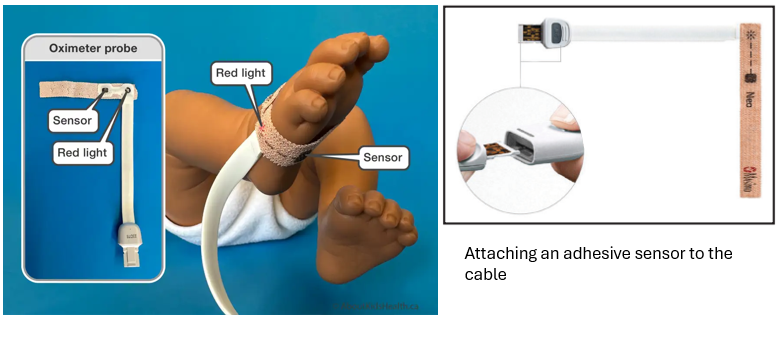ALERT: How to maintain the cables and sensors (probes) of Masimo pulse oximeters in home and community?
Connected Care Quick Hits are up to date and evidence based recommendations for the care of children with medical complexity & technology dependence, from hospital to home.
ALERT: How to maintain the cables and sensors (probes) of Masimo pulse oximeters in home and community?
SITUATION:
This QuickHit was informed by Connected Care safety reports related to damaged oximeter cables and sensors caused by improper handling or incorrect cleaning in home and community settings
BACKGROUND:
Children with medical complexity may require oximeters at home to alert caregivers of sudden drops in the child’s oxygen saturations (SpO2) and heart rate. Oximeters also inform the caregiver of potential oxygen or equipment failures and guides treatment decisions, such as adjusting or discontinuing oxygen therapy. Oximeters also monitor the child's response to therapies or changes in treatment.
Oximeters, sensors and associated supplies are provided to eligible patients under 19 years of age through the Ontario Ventilator Equipment Pool Program (VEP). Two models of oximeters that are provided include the Masimo Rad-8 and the Masimo Rad-G .
An oximeter includes the main unit, sensor, single patient cable, and power cord. To ensure the device functions correctly and provides accurate monitoring for the child, it is essential to properly maintain these components as per recommended guidelines
ASSESSMENT:
An oximeter measurement is taken by placing a sensor on the child at a point where a pulse can be detected easily. For babies and younger children, this is usually the outer aspect of the foot, toes or hand. For school-aged children, toes and fingers work best.
Oximeter cables and sensors are prone to damage from improper handling, such as frequent pulling of the sensor (common with active children) or using the wrong cleaning reagents. This can lead to inaccurate oximeter readings or difficulty obtaining a proper signal (Masimo Sensor Application).
RECOMMENDATION:
Connected Care recommends the following to maintain oximeters in home and community settings:
Ensure Cables and Sensors are cleaned with approved chemical reagents only
Clean by wiping with 70% isopropyl alcohol pad or mild detergent or if low level disinfectant is required, use a 1:10 bleach/water solution. A complete list of cleaning reagents can be found in the Masimo Operator’s Manual (Chapter 9). Ensure the sensor and cable are properly dried after cleaning
Ensure proper handling of the probes and cables
Avoid overwrapping/coiling the patient cable as this can lead to breaking of the internal wires.
Do not immerse the sensor or cable in any liquid solution, oversaturate with the cleaning solution, clean by steam or autoclave, use any reagent other than what is recommended.
Ensure proper orientation when connecting cables to the sensor.
Ensure you are not forcing the cable when disconnecting it from the unit.
Ensure correct application of the probe
The light on probe should be positioned on top of a finger, toe or on the side of the foot, with the sensor being placed directly opposite to this.
Probe and Cable Replacement
Replace tape on the adhesive sensors as needed and change sensors approximately every 2 weeks, or more
Always ensure a spare sensor is available and order additional sensors from the VEP prior to opening the last remaining one
The cable should last up to 2 years.
Review the AKH articles
Other important reminders:
High and low SpO2 and/or heart rate alarm settings are prescribed by the responsible provider (MD or NP) and should only be changed if there is a new order.
Consult Connected Care Live if you have any questions regarding the child, the oximeter reading, or general inquiries.
Speak to the VEP if you require troubleshooting help or if the oximeter has malfunctioned and you require a replacement.














